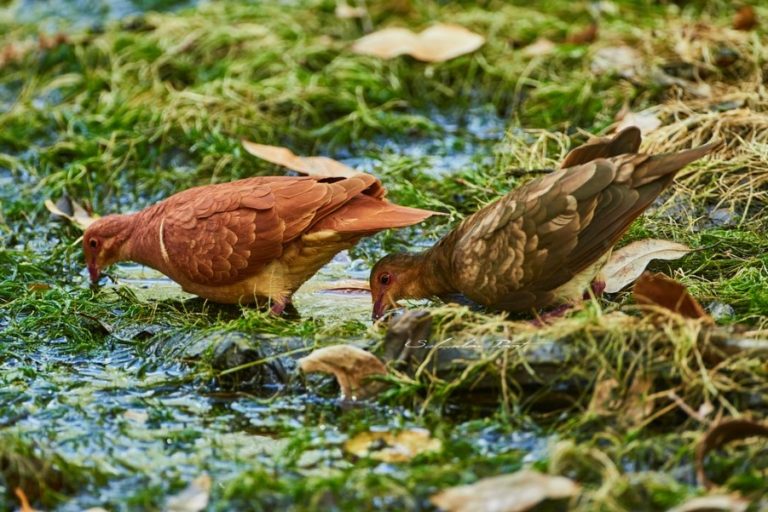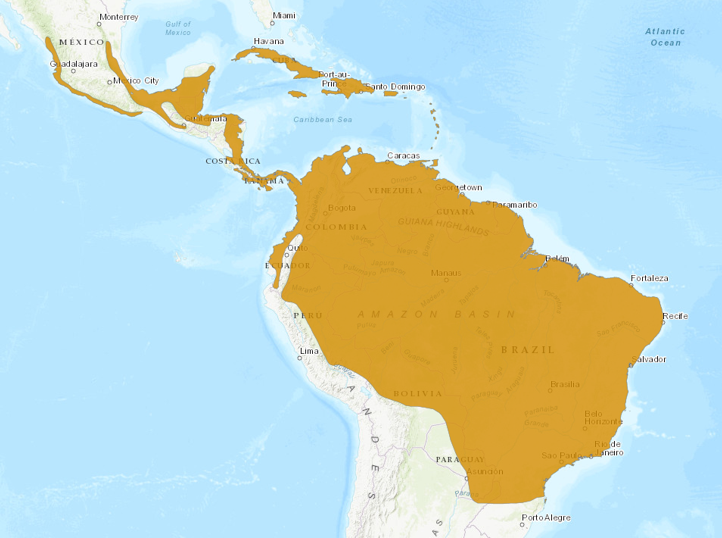Birdfinding.info ⇒ Fairly common across most of its large range, but usually shy and infrequently seen. Some areas where it can often be seen include: Bermejas Wildlife Refuge (Cuba); Ecclesdown Road (Jamaica); the Rabo de Gato Trail (Dominican Republic); Guánica State Forest (Puerto Rico); Bosque del Rio Tigre (Costa Rica); Trilha do Tucanos (São Paulo, Brazil); and most, if not all, of the Amazonian ecolodges.
Ruddy Quail-Dove
Geotrygon montana
Tropical forests from Mexico and Cuba to Uruguay. Widespread in humid and deciduous forests. Somewhat tolerant of disturbed habitats, including plantations and tall second growth.
In the West Indies, resident on Cuba, Jamaica, Hispaniola, Puerto Rico, sparingly into the Virgin Islands (Vieques, St. Croix, and St. John), and separately on the Lesser Antilles from Antigua to Trinidad. (It is the slightly larger subspecies martinica, the “Lesser Antillean Quail-Dove,” on Antigua, Guadeloupe, Dominica, Martinique, St. Lucia, St. Vincent, and Grenada.)
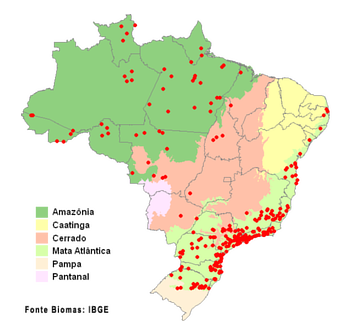
Brazilian records from © WikiAves
In Middle America, occurs in lowlands and foothills of both slopes from Mexico (Sinaloa and Tamaulipas) southward, but uncommon and local on the Pacific slope north of Costa Rica.
In South America: occurs along the humid Pacific slope and intermontane valleys of Colombia and Ecuador, east locally across northern Venezuela; throughout Amazonia, including eastern Venezuela and the Guianas, south to the Pantanal; and in the Atlantic Forest region from Paraíba south to eastern Paraguay, northern Argentina (Misiones), and Uruguay. Mostly absent from the Brazilian cerrado and caatinga biomes.
Movements. Partly migratory or at least dispersive in some parts of its range. In the U.S. there are several records of vagrants from southern Florida and at least one from southern Texas.
Identification
Male is unique and unmistakable: a plump, mostly terrestrial dove with plumage suffused throughout with rusty, orange, and rosy tones.
Also known by its pale and dark whisker-stripes (a pattern shared with several other quail-doves), a pale vertical bar on the side of the breast, and its peculiar head shape: the forehead tapers evenly to the tip of the bill, giving it a snout-like appearance.
The border between darker and lighter tones is often ragged and uneven, especially on its neck and chest.

Ruddy Quail-Dove, male. (Joinville, Santa Catarina, Brazil; November 12, 2016.) © Cláudio Dias Timm
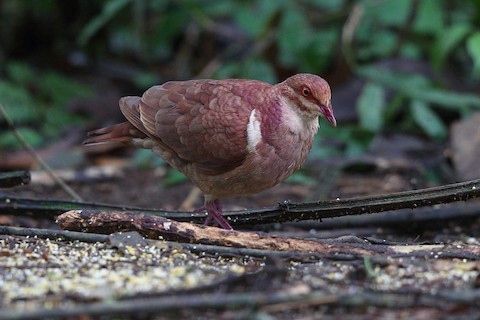
Ruddy Quail-Dove, male. (Villa Carmen Biological Reserve, Cuzco, Peru; July 24, 2018.) © Jon Irvine
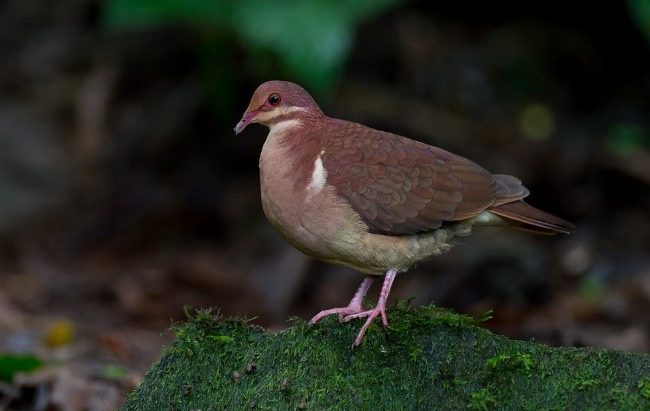
Ruddy Quail-Dove, male. (Joinville, Santa Catarina, Brazil; March 6, 2016.) © João Quental

Ruddy Quail-Dove, male. (Bosque da Ciência-INPA, Manaus, Amazonas, Brazil; October 2013.) © Anselmo d’Affonseca
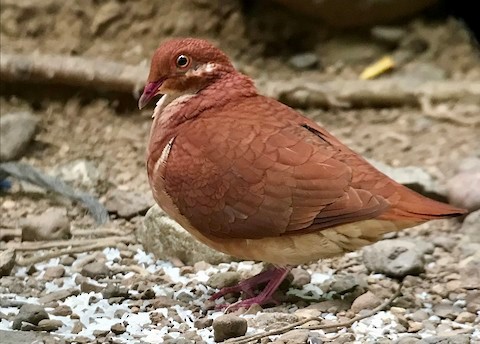
Ruddy Quail-Dove, male. (Bosque del Rio Tigre Lodge, Costa Rica; March 7, 2019.) © Paul Koker

Ruddy Quail-Dove, male. (San Sebastián de la Selva Private Reserve, Misiones, Argentina; June 25, 2019.) © Andrés Terán
The bare parts—legs, bill, and eyering—are mostly pink.

Ruddy Quail-Dove, male—note iridescent rosy flush on the neck. (Pirai, Santa Catarina, Brazil; November 18, 2018.) © Cesar Lacerda
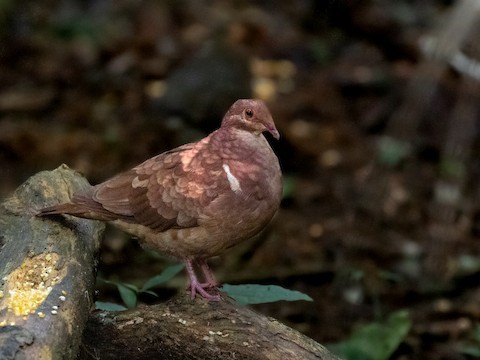
Ruddy Quail-Dove, male showing the pale vertical bar on the side of the breast. (Tremembé, São Paulo, Brazil; May 20, 2019.) © Héctor Bottai

Ruddy Quail-Dove, male with feathers ruffled. (Rabo de Gato Trail, Dominican Republic; November 3, 2014.) © Dax M. Román E.
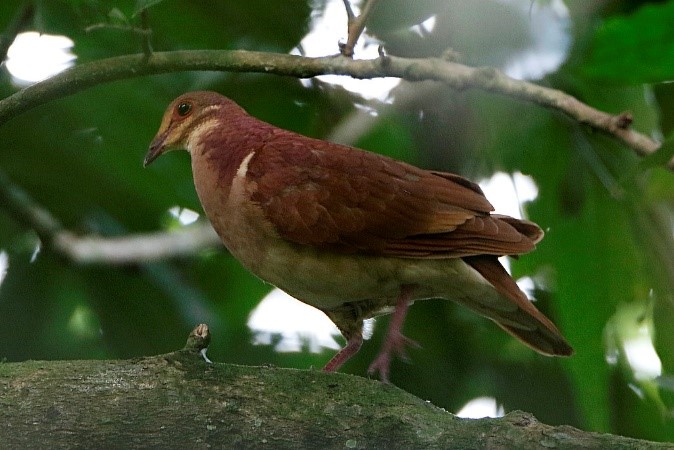
Ruddy Quail-Dove, male—note the ragged border between darker and lighter coloration on its neck and chest. (Lomas Lindas, Dominican Republic; May 4, 2015.) © Dax M. Román E.
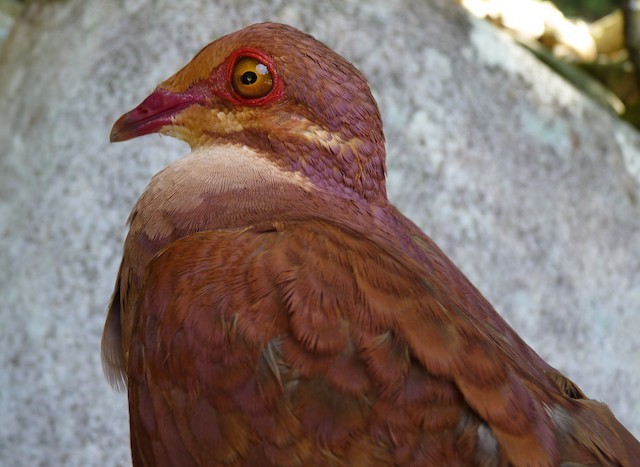
Ruddy Quail-Dove, male, close-up showing detail of peculiar head shape and coloration. (Bosawas, Nicaragua; May 2, 2012.) © Georges Duriaux
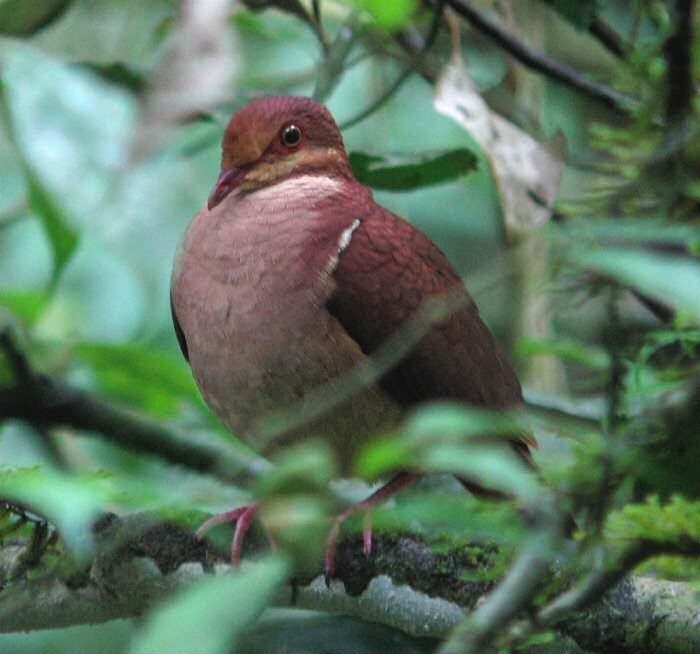
Ruddy Quail-Dove, male with pale vertical bar on the side of the breast partly visible. (Tambopata Research Center, Peru; December 20, 2006.) © Silverio Duri
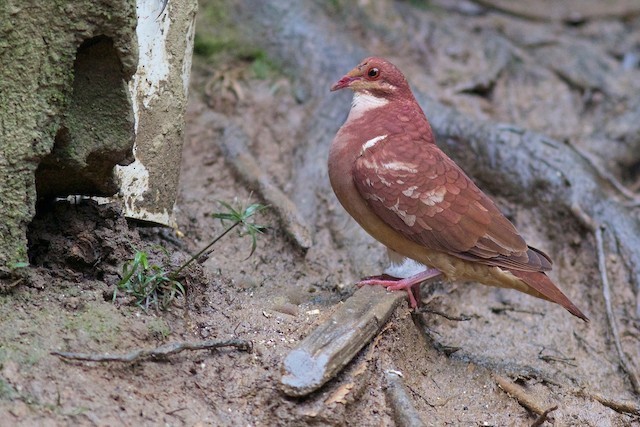
Ruddy Quail-Dove, male showing irregular coloration during molt. (Trilha dos Tucanos, Tapiraí, São Paulo, Brazil; June 13, 2017.) © Luis Matos
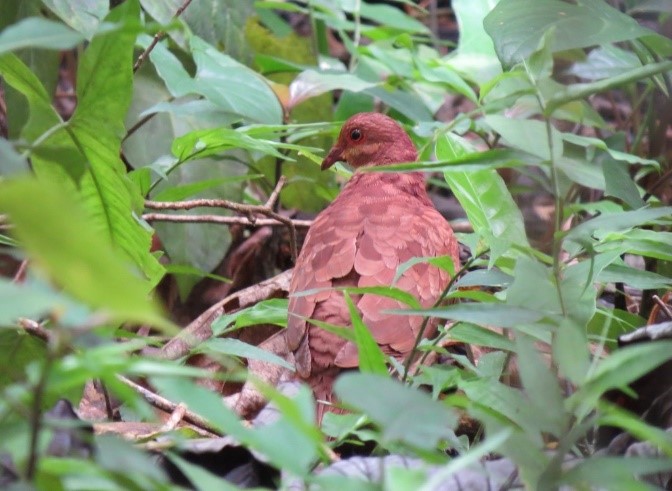
Ruddy Quail-Dove, male, dorsal view. (El Yunque National Forest, Puerto Rico; August 1, 2016.) © Rob Van Epps
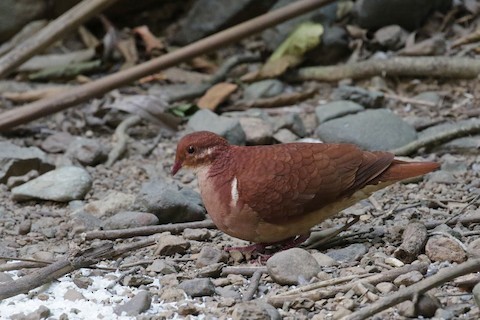
Ruddy Quail-Dove, male showing pale vertical bar on the side of the breast. (Bosque del Rio Tigre Lodge, Costa Rica; February 18, 2019.) © Cameron Eckert
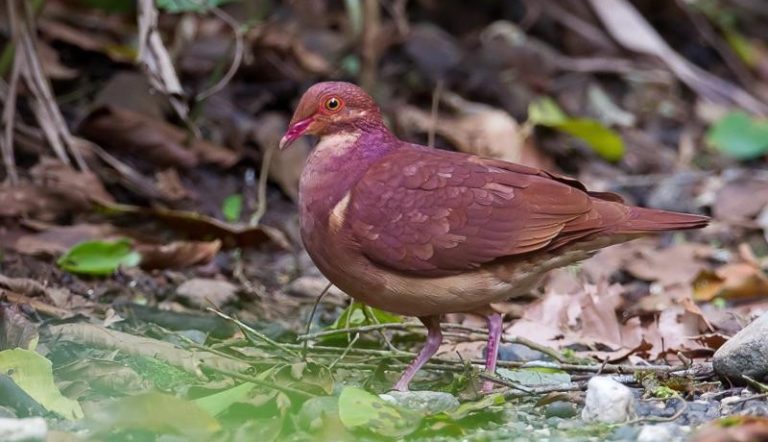
Ruddy Quail-Dove, male—note iridescent rosy flush on the neck. (Bosque del Rio Tigre Lodge, Costa Rica; June 16, 2017.) © Paul van Giersbergen
The “Lesser Antillean Quail-Dove” (martinica) is similar to the widespread nominate form but about 10% larger.
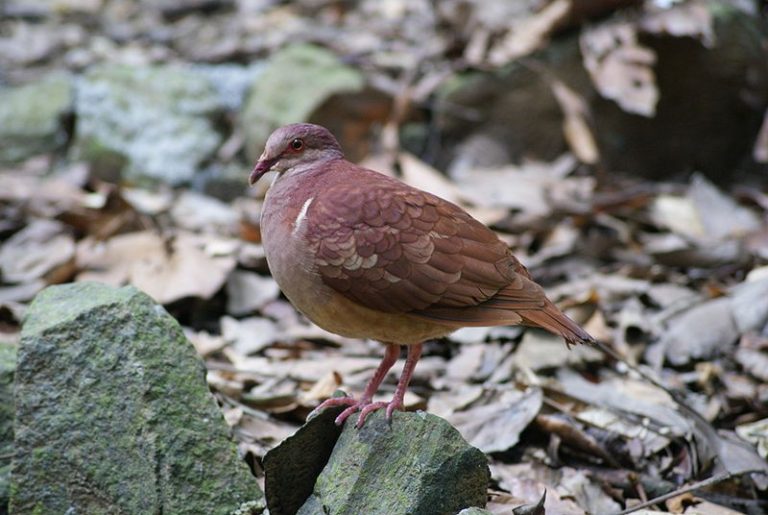
“Lesser Antillean Quail-Dove,” G. m. martinica, male. (Parc des Mamelles, Guadeloupe; April 4, 2010.) © Kim Hansen
Females and immatures have mostly plain brownish and buffy plumage and could be confused with other quail-dove species that may occur alongside Ruddy in various parts of its large range.
In these plumages, Ruddy can usually be recognized by its unusual head shape, orange-buffy face, pink bill and eyering, whisker stripe (sometimes indistinct), and pale bar on the side of the breast (unless concealed by the folded wing).
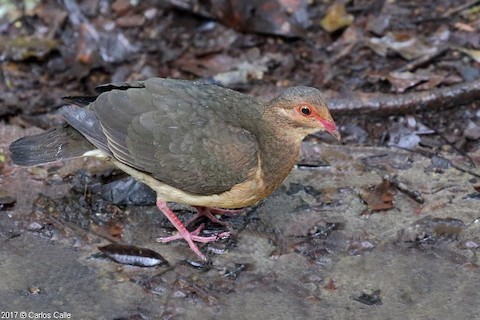
Ruddy Quail-Dove, female showing typical dull-brown upperparts, buffy face and underparts, muted facial pattern, and pink bare parts. (Arena Blanca Reserve, San Martín, Peru; April 13, 2017.) © Carlos Calle Quispe
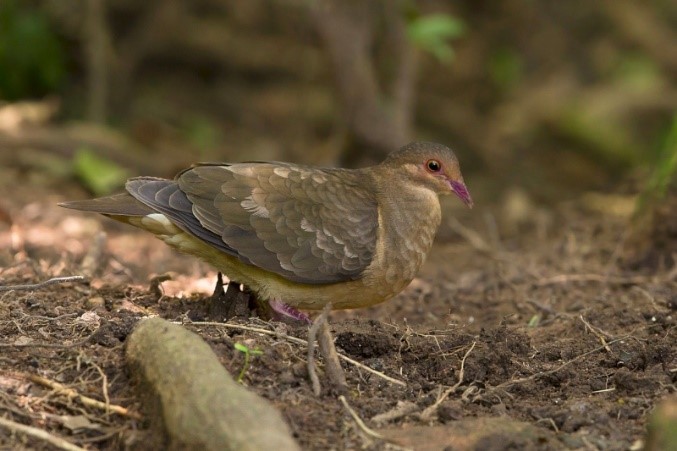
Ruddy Quail-Dove, typical female. (Santa Catarina, Brazil.) © João Sérgio Barros F. de Souza

Ruddy Quail-Dove, female with dull-brown coloration overall. (Tikal National Park, Guatemala; April 7, 2019.) © Carlos Echeverría
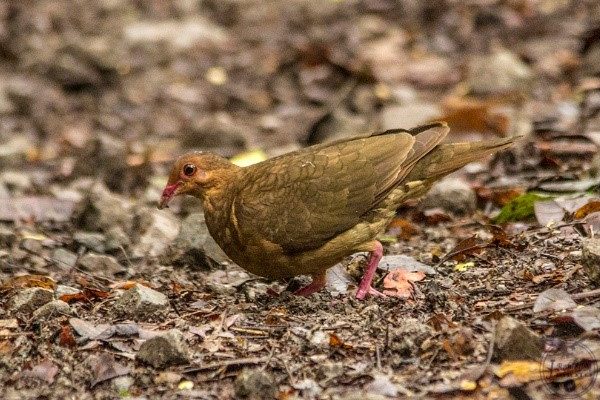
Ruddy Quail-Dove, female with predominantly rusty plumage. (San Blas, Nayarit, Mexico; July 21, 2019.) © Jaime Robles
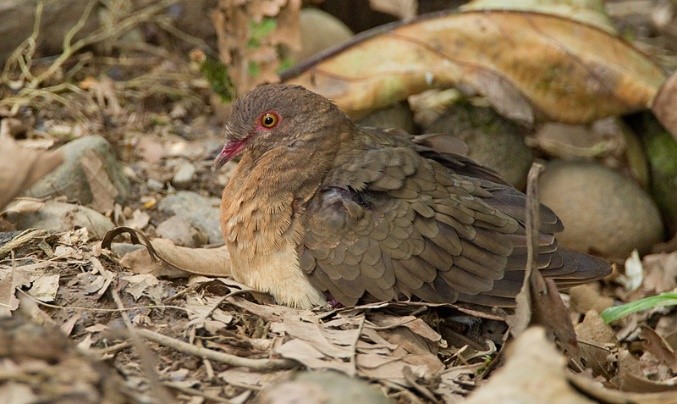
Ruddy Quail-Dove, female lacking detectable facial pattern. (La Selva Biological Station, Costa Rica; February 27, 2015.) © Paul Cools
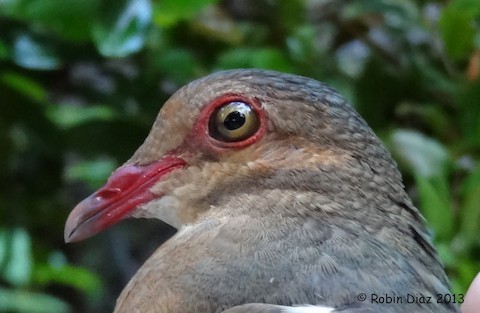
Ruddy Quail-Dove, female, close-up showing detail of facial pattern and pink bare parts. (Bill Baggs Cape Florida State Park, Florida; October 3, 2013.) © Robin Diaz
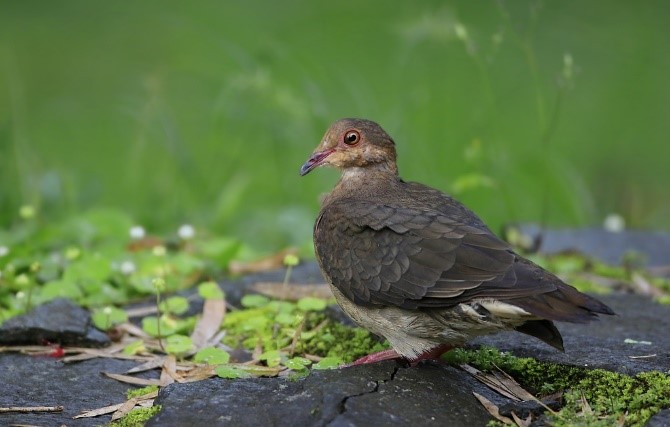
Ruddy Quail-Dove, female with dull-brown coloration overall. (Turrialba, Costa Rica; March 13, 2015.) © Steven Easley
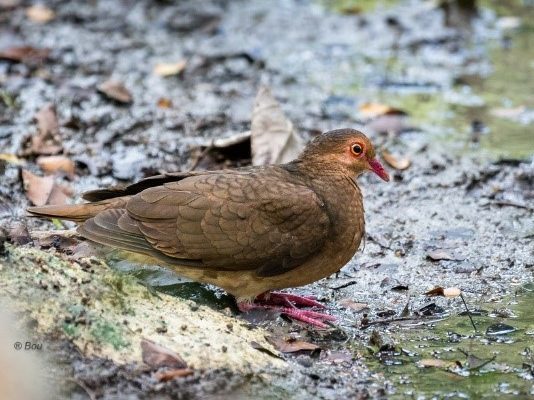
Ruddy Quail-Dove, female. (Calakmul, Campeche, Mexico; July 25, 2018.) © Juan Bou Riquer
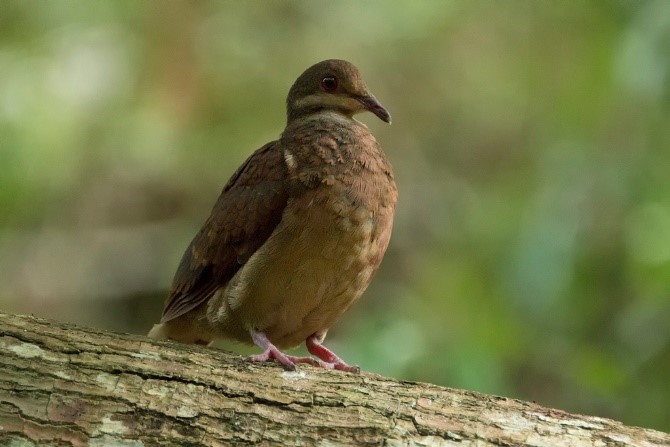
Ruddy Quail-Dove, female or immature male. (Los Arroyos, Dominican Republic; December 29, 2017.) © Pedro Genaro Rodriguez
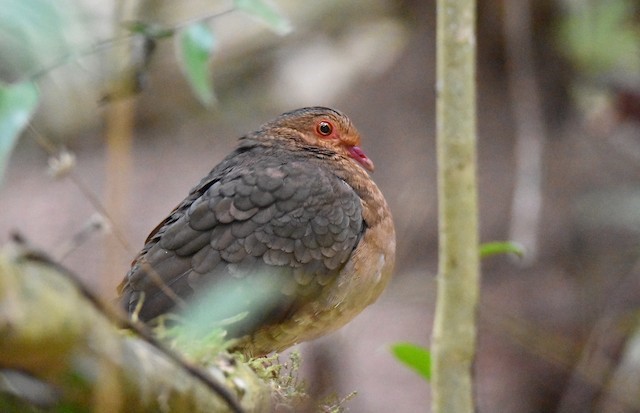
Ruddy Quail-Dove, female or immature male showing dull-brown upperparts and largely orange underparts. (Plantation Road, Panama; March 18, 2016.) © Luke Berg
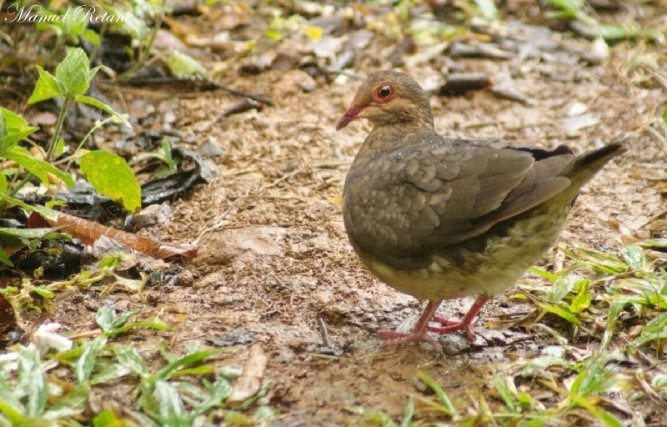
Ruddy Quail-Dove, female. (San Isidro de General, Costa Rica; January 2, 2014.) © Manuel Retana
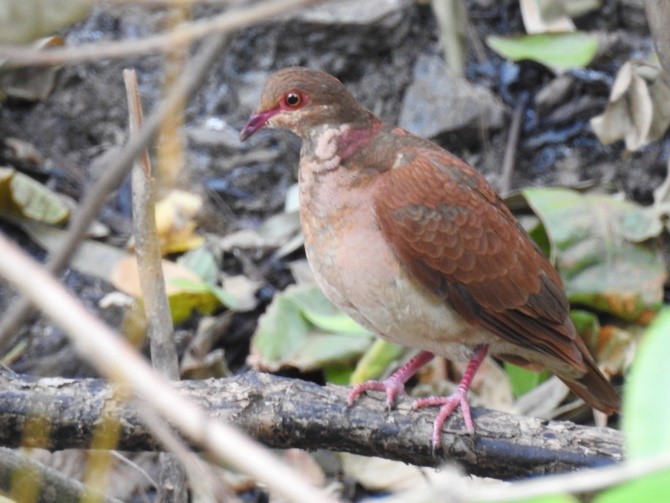
Ruddy Quail-Dove, immature male molting into adult plumage. (Trinidad, Sancti Spíritus, Cuba; April 19, 2017.) © Gera Guzman

Ruddy Quail-Dove, immature male molting into adult plumage, showing iridescent rosy flush on neck. (Sendero Quebrada Bonita, Carara National Park, Costa Rica; April 19, 2019.) © Guillermo Saborío Vega
Notes
Polytypic species consisting of two recognized subspecies: the widespread nominate form and martinica, the “Lesser Antillean Quail-Dove,” which was formerly classified as separate species.
References
Alderfer, J., and J.L. Dunn. 2014. National Geographic Complete Birds of North America (Second Edition). National Geographic Society, Washington, D.C.
Ascanio, D., G.A. Rodriguez, and R. Restall. 2017. Birds of Venezuela. Christopher Helm, London.
Baptista, L.F., P.W. Trail, H.M. Horblit, P. Boesman, G.M. Kirwan, and E.F.J. Garcia. 2019. Ruddy Quail-dove (Geotrygon montana). In Handbook of the Birds of the World Alive (J. del Hoyo, A. Elliott, J. Sargatal, D.A. Christie, and E. de Juana, eds.). Lynx Edicions, Barcelona. https://www.hbw.com/node/54255. (Accessed September 8, 2019.)
BirdLife International 2016. Geotrygon montana. The IUCN Red List of Threatened Species 2016: e.T22690966A93296836. http://dx.doi.org/10.2305/IUCN.UK.2016-3.RLTS.T22690966A93296836.en. (Accessed September 8, 2019.)
eBird. 2019. eBird: An online database of bird distribution and abundance. Cornell Lab of Ornithology, Ithaca, N.Y. http://www.ebird.org. (Accessed September 8, 2019.)
EcoRegistros. 2019. Registros Ecológicos de la Comunidad. Cotorra. http://www.ecoregistros.org/ficha/Myiopsitta-monachus. (Accessed September 8, 2019.)
Fagan, J., and O. Komar. 2016. Peterson Field Guide to the Birds of Northern Central America. Houghton Mifflin Harcourt, New York.
ffrench, R. 2012. A Guide to the Birds of Trinidad & Tobago (Third Edition). Cornell University Press, Ithaca, N.Y.
Garrido, O.H, and A. Kirkconnell. 2000. Field Guide to the Birds of Cuba. Cornell University Press, Ithaca, N.Y.
Garrigues, R., and R. Dean. 2014. The Birds of Costa Rica: A Field Guide (Second Edition). Cornell University Press, Ithaca, N.Y.
Gibbs, D., E. Barnes, and J. Cox. 2001. Pigeons and Doves: A Guide to the Pigeons and Doves of the World. Yale University Press, New Haven, Connecticut.
Haynes-Sutton, A., A. Downer, R. Sutton, and Y.-J. Rey-Millet. 2009. A Photographic Guide to the Birds of Jamaica. Princeton University Press, Princeton, N.J.
Howell, S.N.G., I. Lewington, and W. Russell. 2014. Rare Birds of North America. Princeton University Press, Princeton, N.J.
Howell, S.N.G. and S.W. Webb. 1995. A Guide to the Birds of Mexico and Northern Central America. Oxford University Press, Oxford.
Kuecker, Z., C.A. Soberanes-González, C.I. Rodríguez-Flores, M. del Coro Arizmendi, and T. Johnson. 2012. Ruddy Quail-Dove (Geotrygon montana), version 1.0. In Neotropical Birds Online (T.S. Schulenberg, ed.). Cornell Lab of Ornithology, Ithaca, New York. https://doi.org/10.2173/nb.ruqdov.01.
Latta, S., C. Rimmer, A. Keith, J. Wiley, H. Raffaele, K. McFarland, and E. Fernandez. 2006. Birds of the Dominican Republic and Haiti. Princeton University Press, Princeton, N.J.
McMullan, M., and T. Donegan. 2014, Field Guide to the Birds of Colombia (Second Edition). Fundación Proaves de Colombia, Bogotá.
Raffaele, H. 1989. A Guide to the Birds of Puerto Rico and the Virgin Islands. Princeton University Press, Princeton, N.J.
Raffaele, H., J. Wiley, O. Garrido, A. Keith, and J. Raffaele. 1998. A Guide to the Birds of the West Indies. Princeton University Press, Princeton, N.J.
Ridgely, R.S., and P.J. Greenfield. 2001. The Birds of Ecuador, Volume II: Field Guide. Cornell University Press, Ithaca, N.Y.
Ridgely, R.S., and J.A. Gwynne. 1989. A Guide to the Birds of Panama (Second Edition). Princeton University Press, Princeton, N.J.
Schulenberg, T.S., D.F. Stotz, D.F. Lane, J.P. O’Neill, and T.A. Parker. 2007. Birds of Peru. Princeton University Press, Princeton, N.J.
van Perlo, B. 2009. A Field Guide to the Birds of Brazil. Oxford University Press, Oxford.
WikiAves, Pariri, http://www.wikiaves.com.br/pariri.
